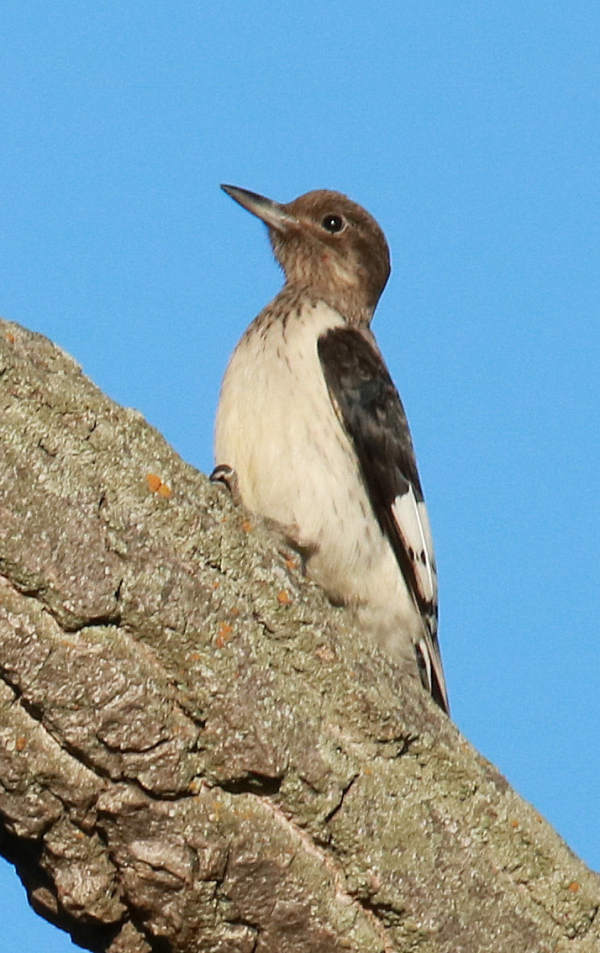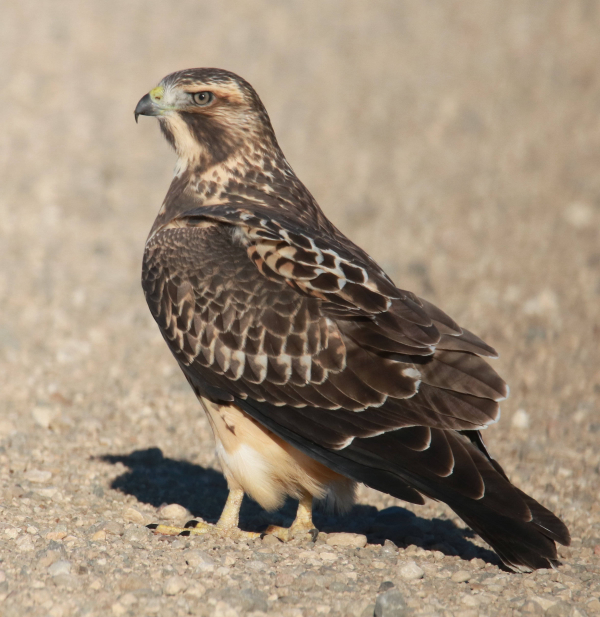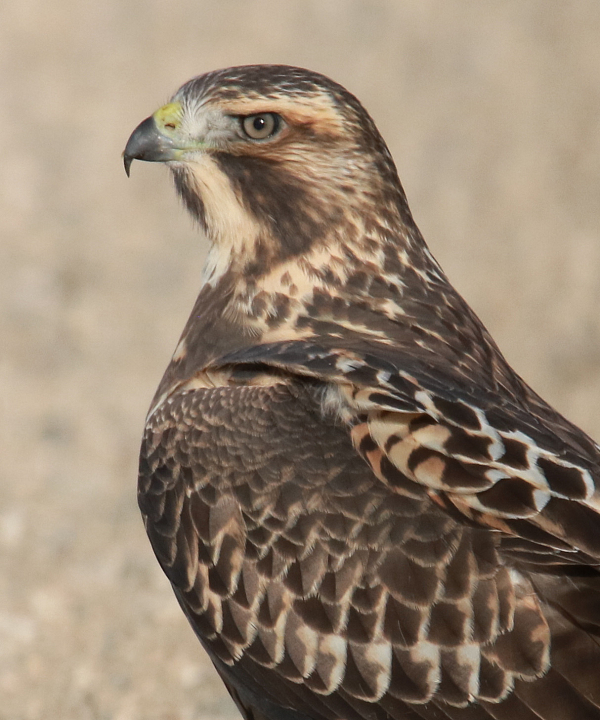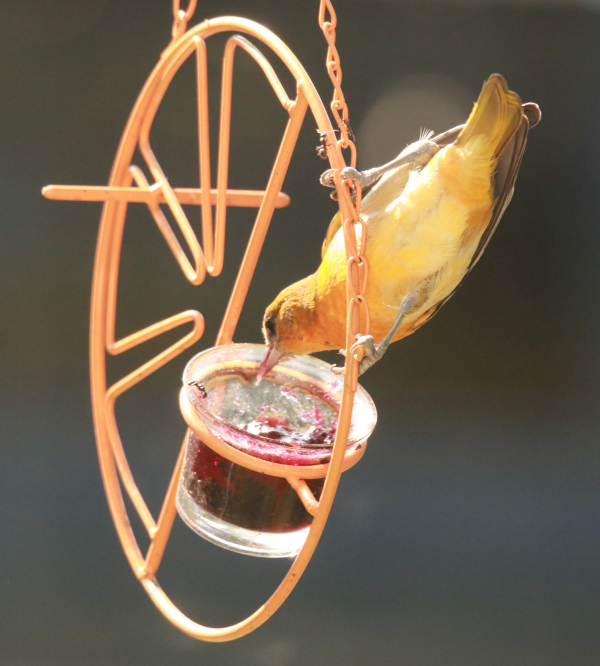
A first-fall Red-headed Woodpecker and its likely sibling provided a fun

The larger female fledgling Swainson’s Hawk has darker markings and provided a different setting as it stood in the midst of a rural road.

A close portrait of the young hawk was created by simply cropping the above photo. That’s not possible with every photo, but when you get a good sharp image, it’s worthwhile to give it a try.

One of the first-fall Baltimore Orioles taking an acrobatic bite of jelly from the circus feeder.
|
The first bird I saw during my afternoon birding drive was big – a first-fall Bald Eagle soaring in ever-higher circles that took it a couple miles to the southeast last Wednesday. The next bird that caught my attention was a new Belted Kingfisher at a wetland where I’ve photographed kingfishers during previous years. How did I know it was a different bird? There was also a Belted Kingfisher at the lakeside bay where I’ve photographed it the past couple weeks, so I assume that’s the same first-fall kingfisher I’ve been seeing there. The new kingfisher is also a first-fall bird, but it seems bigger, so maybe it’s a young female.
Between the 2 kingfishers, which were separated by about 5 miles, I encountered 2 recent Swainson’s Hawk fledglings near where I’ve been seeing them recently. But this time they were perched next to the road – actually, one was on the road, which provided me with much closer looks at the young hawks, both beautiful, with the larger female a bit darker than the male. A half-mile north of the second kingfisher was a surprise first-fall Red-headed Woodpecker on the hunt. This is the first Red-head I’ve seen within several miles of that location, so I expect this was a migrating bird, or at least a post-fledged bird on the move from its nesting area.
Over the past week, fewer and fewer kingbirds have been evident – both Eastern and Western, but there were a few scattered Least Flycatchers, and a couple Say’s Phoebes, which I’m assuming are migrants. Black Terns and Franklin’s Gulls also appear to have vacated the region, although I see a few Common Terns and plenty of Ring-billed Gulls. It’s always easier to note birds arriving than those that leave, but it’s a topic to keep in mind this fall: What’s missing? On my way home I spied another Merlin – there’s still a good movement of the little falcons through the area, as further evidenced by 2 other Merlins I observed Thursday evening.
Friday and Saturday I had an exciting event to attend in Bismarck, which provided me with a couple 130-mile drives across the plains from my home to my hometown. I expected a fun surprise or 2 along the way each day, but the different transects I drove only showed the usual scattering of Red-tailed Hawks, Swainson’s Hawks, and ducks in eclipse plumage. That kind of underscores how rich an area I live in, perhaps because it is on the edge of the 2 geologic sub-regions of the Missouri Coteau and the Drift Plain. And Sunday emphasized that the birds seem to be more diverse and abundant in my region southeast of Bismarck – at least for now.
Sunday Excitement
I started my Sunday birding drive about an hour early, which proved to be a good plan. The first bird I saw was a big soaring Krider’s Red-tailed Hawk that showed its white tail prominently as it circled southeastward in an apparent migration flight. Being Sunday, I was almost alone on the back roads of Dakota, and with the earlier brighter light I was glad to see the young female Belted Kingfisher still hunting the edge of the same shallow wetland where I found her Wednesday and Thursday. This time she permitted me to edge a little closer than during earlier encounters, and I was able to share the next 40 minutes trying to photograph her that resulted in some nice action photos (see the Bird Photography article in this issue).
I always enjoy the extended periods shared with trusting birds, and it’s something I think few birders do, unless they are photographing; and even then, many times we take a photo or a few photos and move on. But it’s definitely worth spending that extra time with a bird when you have the chance, to see some different behaviors and get a better feel for what that species is all about. Kingfishers are usually such active birds that they are perfect examples of how interesting it can be to observe them for an extended time as they search for food, dash into fast direct flights in diving pursuit, diving head-first into the water to catch prey, and flying back to a perch to dispatch it and swallow it if the aerial attack was successful. Often after eating, kingfishers become animated, raising their crest and tipping their tail up and pronouncing their rattling call that is quite endearing to me. All birds seem to share their special qualities if you spend enough time with them, and you never know what a bird might do next.
As I approached the lake where the first (male) kingfisher has been hunting periodically, I observed 3 Northern Flickers, but what was interesting was that a little farther along I observed 4 more, and then 2 other flickers. All this in the area where I found the first-fall Red-headed Woodpecker last Wednesday. But wait, there was a young gray-headed Red-head! Ah, undoubtedly the same bird I saw Wednesday, it was an exciting find, and I managed a couple photos of it.
That’s when I saw the male Belted Kingfisher ahead of me perched above the little bay on the north side of the lake, but it took flight when I was a quarter mile away - hmm. I continued on my usual way with flickers skirting along the road as I drove cautiously, hoping to get a photo of one – but then a comparatively smaller darker-colored woodpecker flew back in my direction, probably displaced by the flickers. I was surprised to see it was another young Red-headed Woodpecker! This one was just north of the little grove of trees where I last saw Wednesday’s bird – so there were 2. I spent some time in that woodpecker hotspot, hoping for some photos, but none were forthcoming – flickers are tough customers to try to photograph in the open prairie. I had some chances to photograph a couple young flickers, apparently in transit within a family group; and at one time I had 4 Northern Flickers clinging to the sides of that same tall wooden pole – what fun.
As I approached my office, it was nice to see some flicker action in my neighborhood too, with a couple flickers hunting ants on the ground on the edge of a large flock of more than a dozen American Robins – a typical fall stopover group in this area.
Feeder Action
By last Wednesday my impression was the minimum of 5 Baltimore Orioles that were present through Tuesday (probably more) dwindled to 1 first-fall oriole. But Thursday there were actually 2 young Baltimore Orioles, both arriving in tandem most of the times they fed at the grape jelly feeder. And Saturday a third young Baltimore was evident, as evidenced by its almost totally gray underside. Ruby-throated Hummingbirds likewise appeared to be reduced to a single bird, but there may be more tomorrow – and last week sure was fun with all the early fall migrant action. The big feeder surprise was the first White-breasted Nuthatch I’ve seen for 3 months, which promptly fed on no-melt suet, as does an occasional male and female Downy Woodpecker.
Then Thursday, I was surprised to see an adult male Northern Flicker at my bird bath (a first), drinking for an extended time, and it even walked into the middle of the clay saucer where I thought it might bathe, but it merely took another drink. My impression was that the flicker was quite thirsty and tired, so I was glad it found a quiet place to stop and drink at my feeding station. While it was drinking, the young orioles stopped to feed, but that didn’t seem to phase the flicker.
Unfortunately, the young orioles were absent Sunday, but a male and female Downy are persisting, at least until the rains came Monday. Maybe there will be an influx of birds after the hours of soaking rain passes.
Ash Tuesday
Tuesday dawned sunny and the Downy Woodpeckers were in full force at the suet feeders along with a White-breasted Nuthatch, but the real excitement was a bit later when an influx of fall warblers all seemed attracted to forage at the ash tree adjacent to my feeding station. First a young Cape May Warbler, then a quick look at an active Black-and-White Warbler working the ash tree’s bark near the base of the trunk. About midday (1pm) a nice mini-wave passed by, including a Tennessee Warbler, then the first Yellow-rumped Warbler of fall with a few more following, along with the first Orange-crowned Warblers of fall.
About 15 minutes later I stepped into the bay window to get a closer look at a warbler, when a Brown Creeper, a personal favorite, worked its way around the ash tree’s trunk just 5 feet away. As it disappeared around the other side of the tree a young female Downy Woodpecker flew in and landed on the bay side of the trunk at eye level, where it seemed to rest a few moments, eventually moving to the nearby suet feeder, just as a much bigger female Northern Flicker swooped in to perch on the side of the trunk. Gee this was getting good!
Flickers don’t usually come near my feeding station, but this one seemed to need a rest in the shade of the ash boughs, and after a minute or so it climbed a couple feet higher onto a horizontal branch. And that’s when a male flicker flew in to land a few feet from the female, who reacted by bowing and making a bubbly call for a bit as she faced the male and repositioned on the trunk above her. Now I was kind of stuck in position, trying not to scratch a little itch for fear of alarming the flickers and Downy. And just then, a surprise Red-breasted Nuthatch flew in to forage on a branch a couple feet from the male flicker – nice; and then a second Red-breast joined the first; gee, what’s next? In time they all dispersed, although the female flicker dropped to the ground and began plying the wet soil here and there in search of ants no doubt.
That action broke up the day in a nice way as I added my final touches and last edits to the articles in this week’s issue of The Birding Wire. Ya know, sometimes you don’t need to take a big trip to enjoy a few birding thrills. It’s been another fun week filled with birds, across the region, locally, and outside my bay windows; and I hope your coming week is brightened and delighted by visions of birds!
Article and photos by Paul Konrad
Share your bird sightings and photographs at editorstbw2@gmail.com